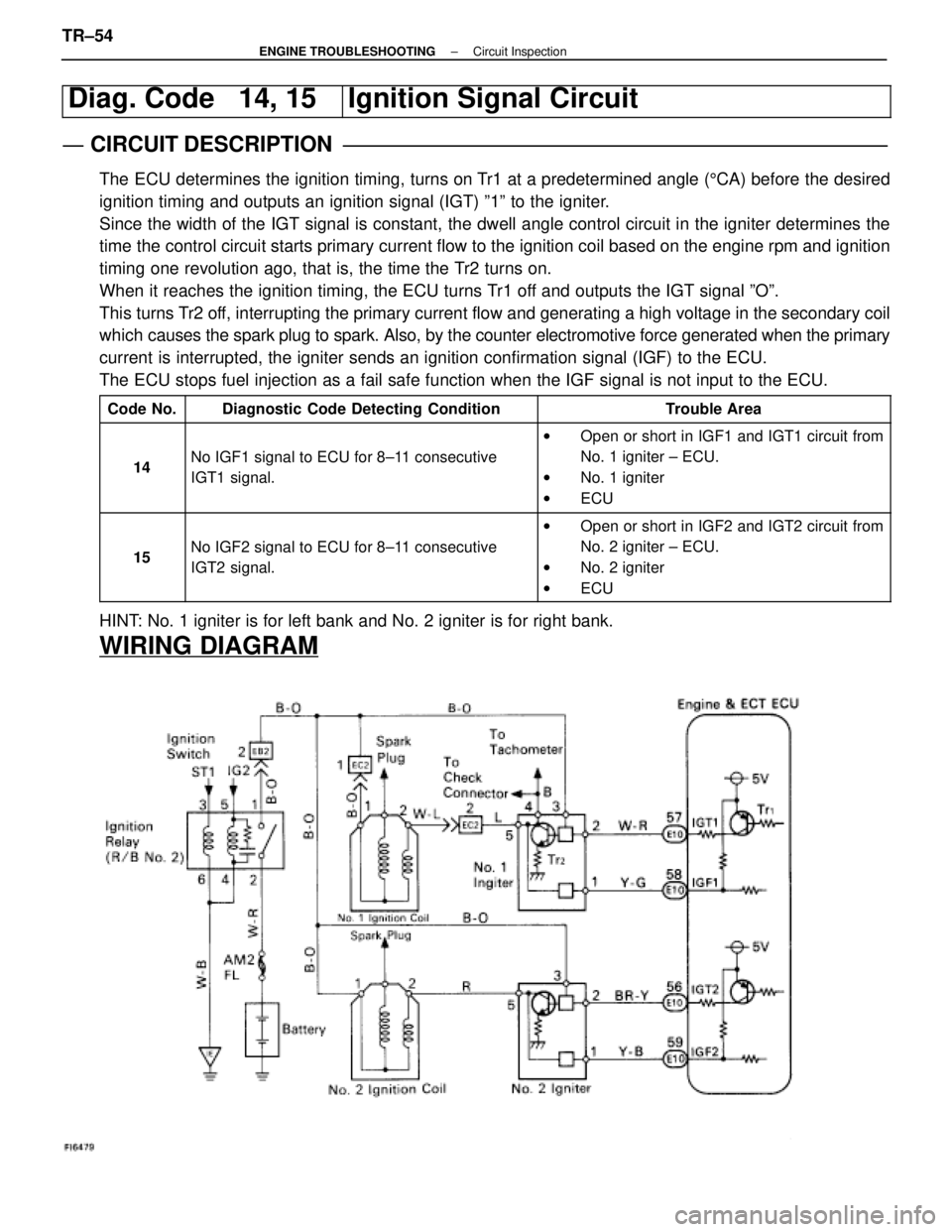Page 3142 of 4087

CAUTION: If a wire harness which is too thin or some oth-
er thing is used to tie down the front passenger airbag as-
sembly, it may be snapped by the shock when the airbag
is deployed, this is highly dangerous.
Always use a wire harness for vehicle use which is at
least 1.25 mm
2 (0.0019 in)2.
(1) Wrap the wire harness around the tire, passing the wire
harness at least 3 times through the installation hole on
the left and right sides of the front passenger airbag as-
sembly.
(2) Position the front passenger airbag assembly inside the tire with the airbag door facing inside.
Tie the wire harness to the tire.
Tire size: Must exceed the following dimensions
Width 185 mm (7.28 in.)
Inner diam 360 mm (14.17 in.)
CAUTION:
wMake sure the wire harness is tight. It is very dangerous
if a loose wire harness results in the front passenger
airbag assembly coming free due to the shock of the
airbag deploying.
w Always tie down the front passenger airbag assembly
with the airbag door facing inside.
NOTICE: The tire will be marked by the airbag deploy-
ment, so use a redundant tire.
3. CONFIRM FUNCTIONING OF SST (See page RS±27)
SST 09082±00700
RS±38
±
SUPPLEMENTAL RESTRAINT SYSTEM FRONT PASSENGER AIRBAG ASSEMBLY
WhereEverybodyKnowsYourName
Page 3154 of 4087

(d) With the center of the sleeve correctly placed between thecrimping jaws, squeeze the crimping tool until either end
comes into contact at the section marked by ªCLOSE HEREº.
HINT: Check to see that the sleeve and wires are still in the
correct position before closing the crimping tool ends with
steady pressure.
(e) Pull the joined wires to either end. Make sure that they are joined firmly by the sleeve.
NOTICE: If the joined wires come loose the splice is de-
fective, so replace the sleeve and repeat the procedure.
(f) Crimp both ends of the sleeve with the crimping tool at the ªINSº position.
4. PROTECT JOINED SECTION Wrap silicon tape around the joins to protect them from water.
HINT:
wBefore starting the operation, throughly wipe dirt and
grease off the sections to be joined.
w If the adhesive surfaces of 2 tapes come in contact, they
will stick together and will not come apart, so do not
remove the backing film except when using the tape.
w Do not let oil and dust, etc., get on the tape surface.
(a) Ready about 100 mm (3.94 in.) of silicon tape (Part No. 08231±00045) and peel off the film.
(b) Stretch the silicon tape until its width is reduced by half.
(c) About 10 mm (0.39 in.) from the end of the pressure contact
sleeve, wrap the silicon tape around the sleeve 3 or more
times while stretching the tape.
RS±50
±
SUPPLEMENTAL RESTRAINT SYSTEM WIRE HARNESS AND CONNECTOR
WhereEverybodyKnowsYourName
Page 3448 of 4087

Diag. Code 14, 15Ignition Signal Circuit
CIRCUIT DESCRIPTION
The ECU determines the ignition timing, turns on Tr1 at a predetermined angle (5CA) before the desired
ignition timing and outputs an ignition signal (IGT) º1º to the \
igniter.
Since the width of the IGT signal is constant, the dwell angle control circuit in the ignit\
er determines the
time the control circuit starts primary current flow to the ignition coil bas\
ed on the engine rpm and ignition
timing one revolution ago, that is, the time the Tr2 turns on.
When it reaches the ignition timing, the ECU turns Tr1 off and outputs the IGT signal ºOº.
This turns Tr2 off, interrupting the primary current flow and generating a high voltage i\
n the secondary coil
which causes the spark plug to spark. Also, by the counter electromotive force\
generated when the primary
current is interrupted, the igniter sends an ignition confirmation signal (IGF\
) to the ECU.
The ECU stops fuel injection as a fail safe function when the IGF signal\
is not input to the ECU.
Code No.Diagnostic Code Detecting ConditionTrouble Area
14No IGF1 signal to ECU for 8±11 consecutive
IGT1 signal.
w Open or short in IGF1 and IGT1 circuit from
No. 1 igniter ± ECU.
w No. 1 igniter
w ECU
15No IGF2 signal to ECU for 8±11 consecutive
IGT2 signal.
wOpen or short in IGF2 and IGT2 circuit from
No. 2 igniter ± ECU.
w No. 2 igniter
w ECU
HINT: No. 1 igniter is for left bank and No. 2 igniter is for right bank.
WIRING DIAGRAM
TR±54±
ENGINE TROUBLESHOOTING Circuit Inspection
WhereEverybodyKnowsYourName
Page 3660 of 4087

Diag. Code 14, 15Ignition Signal Circuit
CIRCUIT DESCRIPTION
The ECU determines the ignition timing, turns on Tr1 at a predetermined angle (5CA) before the desired
ignition timing and outputs an ignition signal (IGT) º1º to the \
igniter.
Since the width of the IGT signal is constant, the dwell angle control circuit in the ignit\
er determines the
time the control circuit starts primary current flow to the ignition coil bas\
ed on the engine rpm and ignition
timing one revolution ago, that is, the time the Tr2 turns on.
When it reaches the ignition timing, the ECU turns Tr1 off and outputs the IGT signal ºOº.
This turns Tr2 off, interrupting the primary current flow and generating a high voltage i\
n the secondary coil
which causes the spark plug to spark. Also, by the counter electromotive force\
generated when the primary
current is interrupted, the igniter sends an ignition confirmation signal (IGF\
) to the ECU.
The ECU stops fuel injection as a fail safe function when the IGF signal\
is not input to the ECU.
Code No.Diagnostic Code Detecting ConditionTrouble Area
14No IGF1 signal to ECU for 8±11 consecutive
IGT1 signal.
w Open or short in IGF1 and IGT1 circuit from
No. 1 igniter ± ECU.
w No. 1 igniter
w ECU
15No IGF2 signal to ECU for 8±11 consecutive
IGT2 signal.
wOpen or short in IGF2 and IGT2 circuit from
No. 2 igniter ± ECU.
w No. 2 igniter
w ECU
HINT: No. 1 igniter is for left bank and No. 2 igniter is for right bank.
WIRING DIAGRAM
TR±54±
ENGINE TROUBLESHOOTING Circuit Inspection
WhereEverybodyKnowsYourName
Page:
< prev 1-8 9-16 17-24